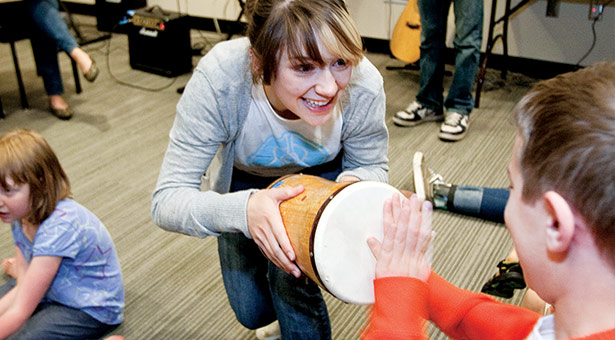The City Urban Perspectives
The Healing Power of Music
EMP and SPU Team Up for a Quieter Kind of Camp
By Laura Onstot '03 | Photos by Mike Siegel

Amanda Sullivan, a sophomore music therapy major at SPU, gave campers a chance to try making their own music at music therapy camp.
A newly formed band gets behind their instruments at Seattle's EMP Museum and begins to rock. Shades on, drumsticks up, these kids are about to bring an '80s rock anthem to life.
It's a regular occurrence at the EMP, but unlike most visitors to the museum, many of these small
stars live with autism spectrum disorders and other disabilities.
The museum's two-week music therapy camp this summer was the vision of Carlene Brown, associate professor of music and chair of the Music Department at Seattle Pacific University.
Brown is also creator of Washington state's first undergraduate program in music therapy. Music therapy, Brown explains, is “when you learn how to use music intentionally to work with clients in any number of settings from working with autistic children to people who are in pain to stroke victims.”
The goal isn't entertainment, though that can be a byproduct. Instead, music therapy uses music to manage stress, alleviate pain, or enhance memory. Brown notes that former U.S. Senator Gabrielle Giffords, recovering from gunshot wounds, is using music therapy to relearn speech.
Brown didn't intend to start a music therapy program when she arrived at Seattle Pacific, but found a student body hungry for more innovative approaches to education across disciplines. “It was the students' insistence that I see whether or not I could bring that here.”
Andy Zook '11 arrived at SPU intending to study music, but without a clear picture of what that might look like as a career. During his freshman year, he volunteered with the Fred Hutchinson
Cancer Research Center, giving music lessons to kids whose siblings were receiving therapy.
Brown saw a spark. “She asked if I was interested in that sort of work,” Zook recalls. Until that moment he had never heard of music therapy. By his sophomore year, he had enrolled in the
fledging program.
Becoming Rock Stars
While Brown built the music therapy program at SPU, Patricia Costa Kim, then education director at the EMP and a colleague of Brown's from graduate school, was seeking ways to reach out to people who are often left out of museum experiences.
The two began developing the idea for a camp with exhibits retooled to meet the needs of kids who might otherwise be overwhelmed by the lights, noise, and general hubbub of the typical museum. Zook joined the project as a staff member.
Kim died of a brain tumor last May, but Brown, Zook, and the EMP kept working to make the camp a reality.
Jonathan Cunningham, manager of youth programs and community outreach at EMP, says he was very nervous in the days leading up to the camp: “It's a bold undertaking, to bring young people with Asperger's or autism into a place as stimulating as EMP.”
The staff trained extensively on how to work with the kids. They turned down the sound and developed walking routes through the museum designed to reduce sensory input. Brown recruited enough students and other volunteers to guarantee a 1:1 ratio of staff to campers.
One of the trickier things, Cunningham recalls, was figuring out how to make the popular exhibit “On Stage” work. Visitors get to simulate the experience of playing before an arena filled with screaming fans, complete with light and sound. EMP could easily turn down the volume, he says, but the lights didn't work on dimmers. He came up with the solution of having the kids wear EMP sunglasses, which not only solved the light problem, but gave them a dose of rock star cred.
“I think we all felt warm and fuzzy not just that it happened, but that it went really well,” says Cunningham.
Some parents who only signed their children up for the first week returned for the second.
The camp had “a positive impact,” says parent Rose Mayeda, who adds that she wanted to send her son to the camp because it was hosted by SPU: “Very rarely have we encountered other believers who are therapists, during our journey with autism, and it was exciting for us to have [our son] surrounded by people who would see him for more than just a special child with different needs, but a child of God who was given a special gift.”
“What we're doing is changing the atmosphere,” says Zook. “We're changing the societal expectation of what a museum has to be.”
And Seattle Pacific's music therapy program has exploded, with enrollment capped at 25. Brown is expanding partnerships with faculty and students in the special education department. “It took two years to build it,” says Brown, “and now it's thriving.”
